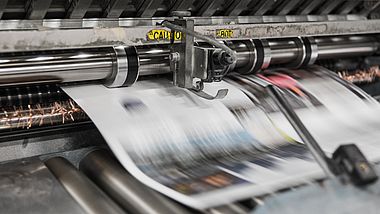Participating companies | Mondas GmbH and badenova WÄRMEPLUS GmbH & Co. KG |
Project location | Freiburg-North industrial area |
Industry | IT industry |
Technologies used | Integration of industrial heat into local heating grid and control via IoT platform |
Energy efficiency | Planned waste heat utilisation: up to 5,000 MWh |
Projected CO2 savings | Planned: 1,200 t CO2/yr |
Investment | Approximately €4.7 million |
Payback period | Approximately 16 years (including funding) |
Funding programmes | Funding from ITG mbH & Co. KG applied for |
Cerdia Produktions GmbH (Cerdia) is at the centre of the project in Freiburg-Nord’s industrial area. Waste heat is generated during production processes. Up to now, the chemical company has used well water as the coolant for its production processes. The heated water is then re-cooled and discharged into a stream. The Smart Green Goal project plans to extract the waste heat (48°C) and feed it into a local heating grid. A transfer station has already been built on the Cerdia site for this purpose. Energy service provider badenova WÄRMEPLUS GmbH built the local heating grid. The main consumer is SC Freiburg’s newly completed stadium (transfer stations for buildings and three turf heaters). Other consumers include the exhibition halls of Messe Freiburg (Freiburg’s exhibition and conference centre), several administrative buildings, a research institute and a car dealership. The complexity of the usage structure means that the heat distribution is controlled via Mondas’ IoT platform, which has already proven itself in several climate protection projects. The algorithms predict the consumers’ individual heat loads in real time. If it appears that the contractually fixed power limit of 6 MW is going to be exceeded, load shifting measures are initiated. The software processes data from weather forecasts, event and match schedules (exhibition and conference centre, stadium) as well as operating times. Furthermore, measured values from the customer’s heat transfer stations, such as thermal output, the amount of heat, operating temperatures and operating feedback, are included in the calculation. In the event of a heat demand greater than 6 MW, the waste heat from Cerdia’s steam condensate and an existing boiler at the exhibition and conference centre can be used as an emergency reserve to supply heat. A load management is in place to prevent the reserves from being needed, thus avoiding additional costs for the consumers. The waste heat grid and IoT platform will be commissioned in autumn 2021.
Transferability
In principle, the approach of utilising industrial waste heat can be applied to any heating grid. This includes industrial waste heat that has remained unusable thus far due to reasons such as temperatures being considered to be too low.
Energy Efficiency Award 2021
Pictures
Above: Photographer Mr. Wallny and the FWTM
Below: Mondas GmbH


![[Translate to English:] Abnehmer Wärmenetz: Stadion des Bundesligisten SC Freiburg; Foto: Wallny, FWTM](/fileadmin/_processed_/e/3/csm_Stadion_des_Bundesligisten_FC_Freiburg_b23c9fabd1.jpg)
![[Translate to English:] Übersicht Intelligentes Lastmanagement](/fileadmin/_processed_/4/5/csm_UEbersicht_Intelligentes_Lastenmanagement_f74102958a.jpg)

